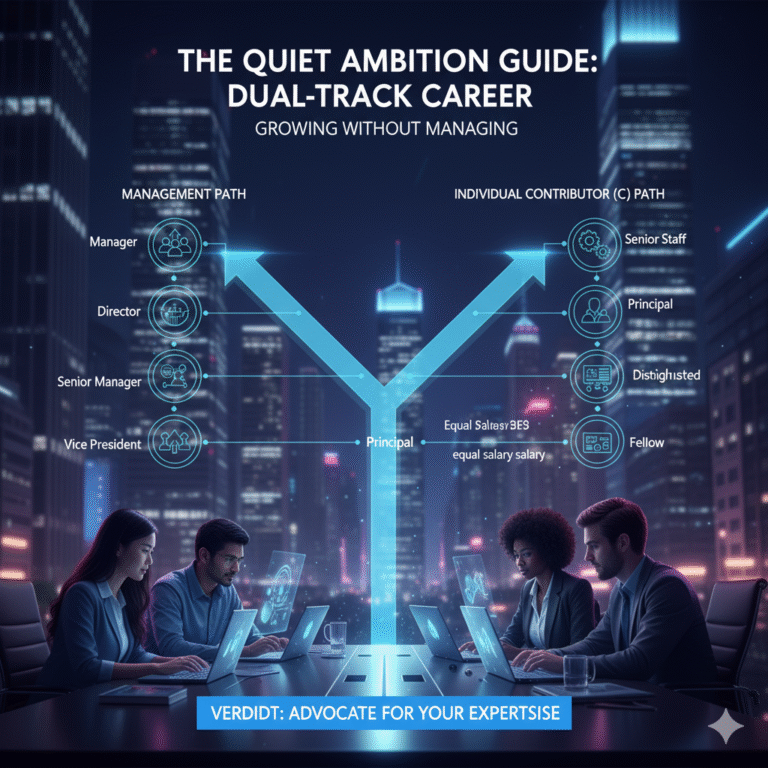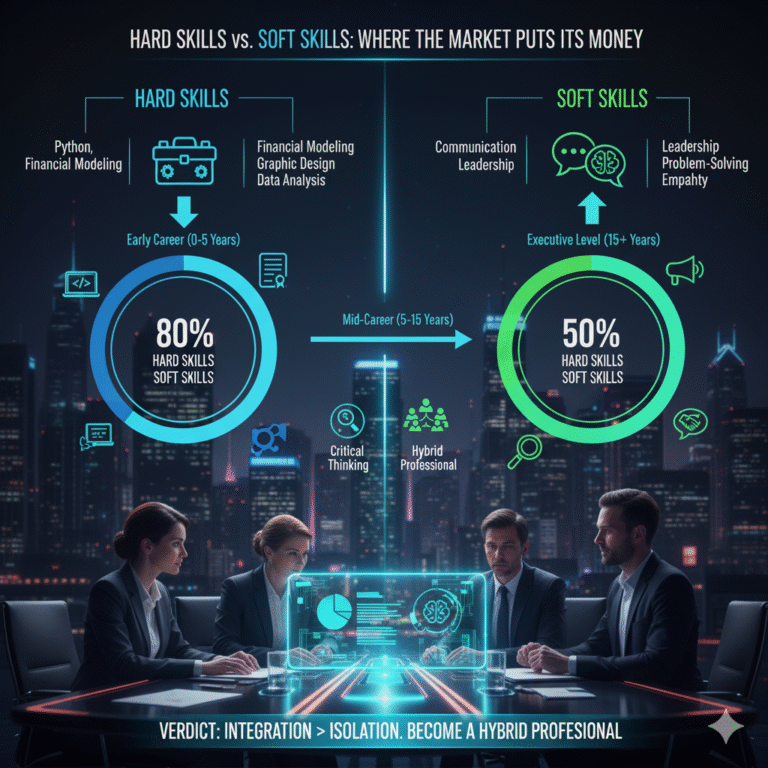Lifelong Learning: The Practical Guide to Staying Relevant in a Constantly Changing Market
There was a time when your career was a simple, two-step process: first, you spent 20 years *learning* (school, university), and then you spent 40 years *working* (applying that knowledge). That model is dead. Today, the “half-life” of a professional skill—the time it takes for a skill to become half as valuable as it once was—is estimated to be as short as 5 years. For technical skills, it’s closer to 2-3 years.
This creates a terrifying new reality: if you stop learning, you don’t just “stay put.” You become obsolete. The software you mastered 3 years ago is being replaced. The marketing channel that was your specialty is now overcrowded. The job title you’re aiming for might not exist in a decade.
“Lifelong learning” is no longer a passive, feel-good buzzword; it is the single most critical, non-negotiable survival strategy for a modern career. This guide is not about “going back to school.” It’s a practical framework for how to integrate continuous learning into your busy life, ensuring you stay relevant, valuable, and marketable for the next 40 years.
The Mindset Shift: From “Finished Product” to “Perpetual Beta”
The first and most difficult step is a psychological one. You must abandon the “finished product” mindset. You are not “done” with your education. You are not a “Master” of your craft, because the craft itself is constantly changing.
The new mindset is that of a “Perpetual Beta.” Like a piece of software, your skillset is never “version 1.0.” You are always in “version 1.8,” “version 2.1,” etc. You are a work-in-progress, constantly seeking bugs (gaps in your knowledge) and new features (new skills) to stay ahead. This mindset removes the ego and replaces it with curiosity. When a new technology emerges, your reaction shifts from “That’s a threat” to “That’s an update. Time to learn it.”
The Practical Framework: How to Build Your “Learning Habit”
“I don’t have time” is the #1 excuse. This is a fallacy. You don’t need 10 hours a week. You need a better *system*. Here is a 5-step framework to make learning an automatic, efficient part of your career.
Step 1: Identify Your “T-Shaped” Gaps
You can’t learn everything. You must be strategic. The most valuable professionals are “T-Shaped”:
- The Vertical Bar ( | ): This is your **Deep Expertise**. Your core skill (e.g., graphic design, financial analysis, software engineering). You must keep this sharp.
- The Horizontal Bar ( — ): This is your **Broad Knowledge**. Your understanding of related fields (e.g., marketing, psychology, data, management). This is what allows you to collaborate and innovate.
Action: Once a quarter, draw your “T.” Ask yourself: 1) “What is the *next* logical step in my deep expertise?” (e.g., “From graphic design to motion graphics”). 2) “What *related* skill would make my core expertise 10x more valuable?” (e.g., “Graphic design + understanding of basic copywriting”). This is your learning plan.
Step 2: Use the “Just-in-Time” vs. “Just-in-Case” Model
This is the secret to efficiency. Stop learning things “just in case” you might need them one day. Prioritize “just-in-time” learning.
- Just-in-Case (JIC) Learning: This is foundational knowledge (e.g., “I’m going to take a 6-month data science course”). This is important but time-consuming. Dedicate only 20% of your learning time here.
- Just-in-Time (JIT) Learning: This is “problem-first” learning (e.g., “I have a project *today* that requires me to build a pivot table. I will watch a 15-minute YouTube video and learn *only* that one skill”). This is 80% of your learning. It’s targeted, immediately applicable, and you retain it because you *use* it.
Step 3: Master “Micro-Learning” (The 30-Minute/Day Rule)
Stop thinking you need to block out an entire Saturday. “Binge-learning” is inefficient and leads to burnout. The habit is more important than the volume.
Action: Find 30 minutes a day. That’s it. It could be your commute (podcasts), your lunch break (industry newsletter), or 30 minutes before bed (a chapter of a non-fiction book). 30 minutes a day is 3.5 hours a week, or over 180 hours a year. That’s the equivalent of 4 full-time work weeks, or two entire university courses. It’s all you need.
Step 4: Build Your “Personal University” (Curate, Don’t Consume)
The internet is a library, but 99% of it is noise. You must become a “curator.” Your goal is to build a “Personal University” of trusted, high-signal sources. Your feed should be smarter than you are.
Action:
- Newsletters: Find the 3-5 *best* newsletters in your niche (e.g., Stratechery for tech, Morning Brew for business).
- X (Twitter) Lists: Create a private X/Twitter list of 50 “thought leaders” in your field. This becomes a curated, ad-free “super-feed.”
- Podcasts: Find 3-4 industry-specific podcasts for “passive learning” during chores or commutes.
- YouTube: Subscribe *only* to high-value channels that teach specific “JIT” skills.
This curated feed will teach you more than a random MBA, and it comes to you automatically.
Step 5: Prove Your Learning (From Consumption to Creation)
This is the most critical step. If you only *consume* information, you will forget it. You must *create* something with it to prove you’ve learned it. This is how you close the “learning loop.”
Action:
- Learn-and-Apply: After learning a new skill (“JIT”), *immediately* apply it to the project you’re working on.
- Learn-and-Teach: After you’ve mastered a concept, write a simple LinkedIn post or internal-team memo about it. (e.g., “I just learned a new Excel formula that saved me 3 hours. Here’s how it works…”).
Teaching is the ultimate proof of knowledge. It forces you to structure your thoughts and exposes your *real* gaps.
How to “Afford” Continuous Learning
Many high-quality courses (on Coursera, edX, or LinkedIn Learning) cost money. If your budget is tight, there is a simple solution: Ask your company to pay for it.
This is the easiest “ask” you can make. It’s a win-win. Go to your manager with a simple business case:
“I’d like to take this $200 ‘Advanced Google Analytics’ course. This is a ‘Just-in-Time’ need for our upcoming website redesign. The skills I learn will allow me to build the custom dashboards we need, which will save us from hiring an external consultant for $3,000.”
No competent manager will ever say no to this. You are not asking for a “perk”; you are asking for a tool to do your job better.
Conclusion: Your Career Is a Subscription, Not a Purchase
Your degree was not the “purchase” of an education. It was the down payment on a subscription to a lifetime of learning. The professionals who become obsolete are the ones who believe they are “finished.”
The professionals who thrive are the “lifelong learners” who treat their curiosity as their greatest asset. They stay relevant not because they are the “smartest,” but because they are the most *adaptable*. Stop seeing learning as a “chore.” See it as the ultimate career insurance.







